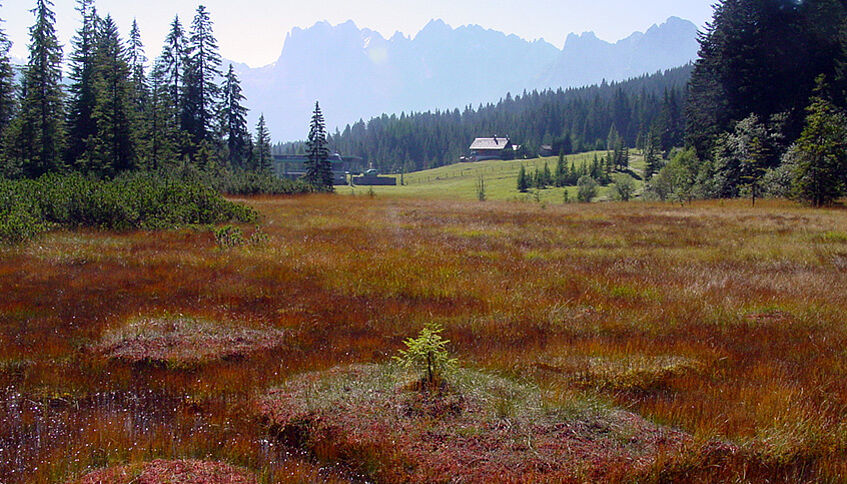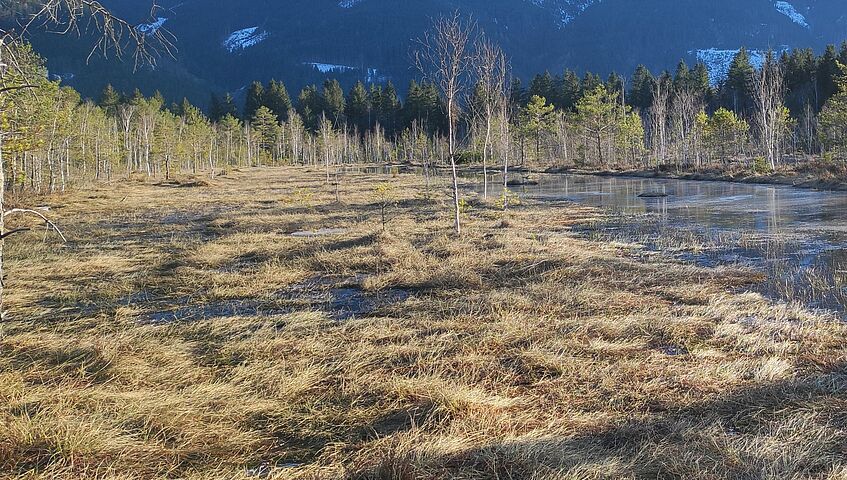Ongoing projects
LIFE AMOORE - Austrian Moor Restauration
The LIFE AMooRe project aims to initiate the implementation of the Austrian Mire Strategy 2030+ and thus to facilitate nationwide peatland protection in Austria. The focus of the Geoecology working group at the University of Vienna (S. Glatzel) within the large-scale project is in particular on researching the emission factors for carbon storage and the release of greenhouse gases from near-natural and disturbed peatlands as well as from agricultural and forestry land on peat soils.

Torfstube Gosau (c) Gert Michael Steiner
Conservation and Restoration of Peatland Biodiversity in Austria
How are the domestic peatlands doing? Which peatlands in Austria are best suited for current and future peatland restoration? By comparing the vegetation of the peatlands - from before the compilation of the Austrian Peatland Conservation Catalogue in 1992 until today - the current conservation status of the peatlands is surveyed. The data collection is spread over seven federal states and all peatland types. The development and state of peatlands allow to estimate the potential of carbon storage through ecological restoration. Additionally, the data will allow to refine climate risk scenarios for peatlands in Austria.

Überlingmoos (c) Constantin Pöll
MOIST – Recording Austria's degraded peatlands and assessing their suitability for restoration
The MOIST project is concerned with recording degraded peatlands in Austria and assessing their suitability for regeneration measures. The focus is on the recording of peatland areas and peat soils, based on the intersection of different data bases, the development of models and supplementary surveys in the field. The result should be distribution maps of organic soils, which will be used in a further step to develop a catalogue of criteria for the possibilities of rewetting measures. This is intended to achieve the overarching goals of the Austrian Mire Strategy 2030+ and the Biodiversity Strategy in order to preserve or restore important ecosystem services.

Pichlmaier Moor (c) Raphael Müller
Dissertation projects
Pamela Baur is working on quantifying and improving the process understanding of methane, carbon dioxide and water vapor fluxes in the reed belt of Lake Neusiedl.
Yujing Deng investigates mechanisms of peat decomposition under climate change and anthropogenic activities.
Kirill Grachev explores the impact of slow-moving landslides on greenhouse gas emissions from soils in Pre-Alpine grasslands.

(c) Geoecology
Ongoing projects
Erhaltung und Wiederherstellung der Biodiversität in Mooren Österreichs
1/05/22 → 31/07/26
Project: Research funding
Austrian Moor Restoration - Integriertes Projekt zur Umsetzung der Moorstrategie Österreich 2030+
Glatzel, S., Maier, A. & Lanthaler, B.
1/01/24 → 31/12/33
Project: Research funding
MOIST - Erfassung degradierter Moorflächen Österreichs und Beurteilung ihrer Eignung zur Regeneration (MORE)
Glatzel, S., Wrbka, T., Hummel, C. & Müller, R.
1/01/24 → 31/10/25
Project: Research funding
